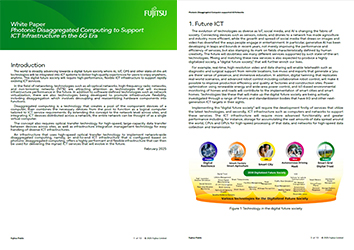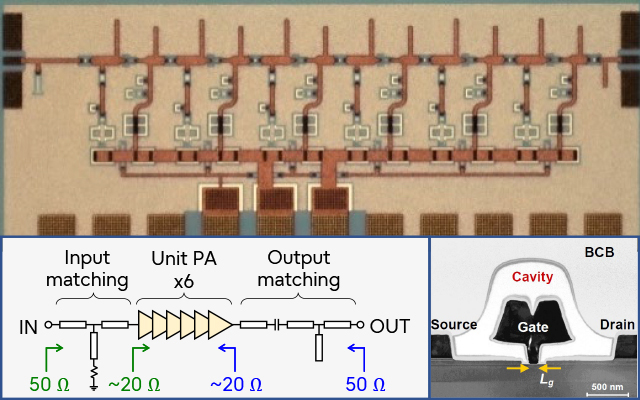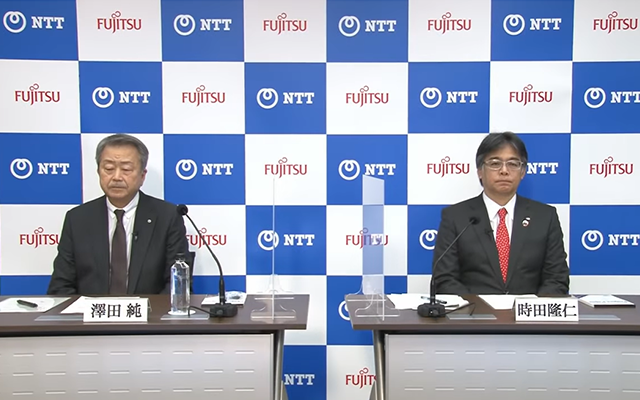R&D activities for 6G
Photonic disaggregated computerThe innovative computing platform for the “digital future society”
JapanesePhotonic disaggregated computer is the computing platform that enables optimal resource deployment and operation by disaggregation and reconfiguration of ICT resources. For the advanced and diversified services, Photonic disaggregated computer realizes high performance processing and low power consumption, both of which are difficult to be achieved at the same time with traditional computing technologies.
With Photonic disaggregated computer, Fujitsu will support various partners in providing services that create new values and contribute to building a sustainable society.
What are the requirements for next generation ICT infrastructure?
In 2030, extremely rich user experiences will be delivered beyond the limitations of distance and time. In the future society in 2030, network will connect among people and various things and innovative services will be provided based on big data.
Why "6G" Now? Fujitsu Sets Sights on 2030What is the requirements for the future ICT infrastructure?
High-performance
The amount of computation required for ICT infrastructure is rapidly increasing, led by the evolution of generative AI. Therefore, a high-performance ICT infrastructure that can perform large-scale calculations at higher speeds is required.
Scalability
Scalability to handle the ever-increasing computational complexity is also important. For example, increasing the number of parallel servers is called "scale-out" and can increase total processing performance. On the other hand, concentrating scaled-out infrastructure in a single location can be difficult in terms of power supply and cooling. Therefore, it is necessary to distribute infrastructures over a wide area and integrate them to achieve scalability.
Low power consumption
ICT related power consumption is expected to explode as ICT infrastructure scales up in response to increasing computing demand. Reducing the power consumption of ICT infrastructure is an urgent task in order to reduce environmental impact.
Flexibility
In the 6G era, people and various devices will be connected to networks, and various services will be created. As a result, the requirements for each service, such as computing power, network bandwidth, and latency, will diversify. This also requires the flexibility to configure an optimal infrastructure based on service requirements and load conditions.
Fujitsu proposes Photonic disaggregated computer as an innovative ICT infrastructure to satisfy these requirements.
* Japan Science and Technology Agency (2019) Impact of Progress of Information Society on Energy Consumption (Vol. 1)Function and benefits of Photonic disaggregated computer
Photonic disaggregated computer is the computing platform that delivers the above requirements which are difficult to be realized at the same time by conventional computing technologies. Photonic disaggregated computer has following three components.
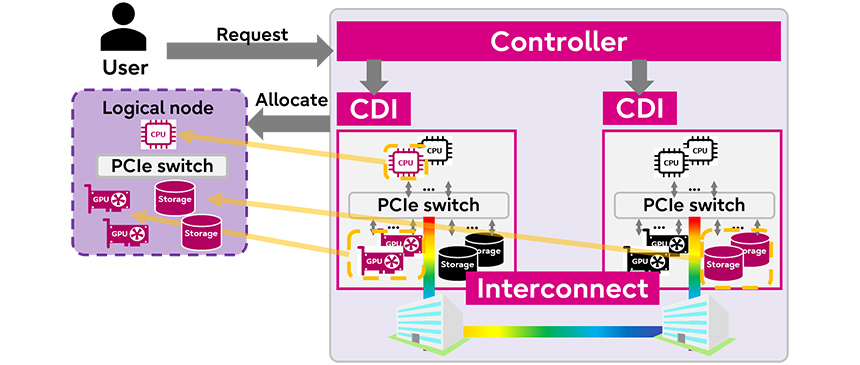
①Composable disaggregated infrastructure(CDI)
While traditional ICT infrastructures are server-oriented architectures, CDI is an architecture which disaggregated resources within server such as CPU, storage, and GPU and pools these resources. This architectural change allows CDI to provide flexible configuration of logical nodes to meet service requirements. In addition, CDI realizes low power consumption of ICT infrastructure by using the minimum resource configuration according to performance requirements and the most suitable accelerator according to processing.
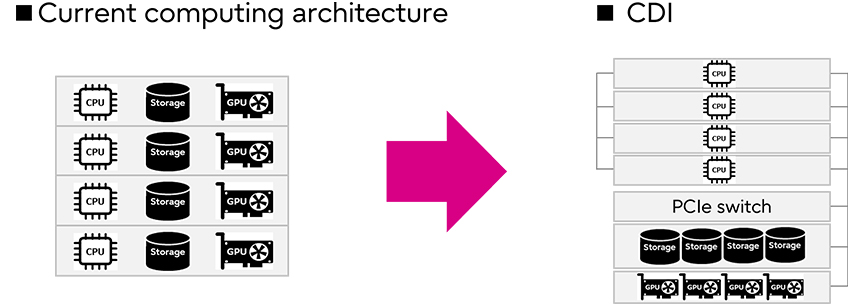
②Interconnect
Photonic disaggregated computer utilizes photonics connection, not electric connection between resources/chips. Taking advantage of photonics technology characterized by high-speed and high energy efficiency, it is able to reduce power consumption and improve processing performance compared to conventional computing.

③Controller
The controller extracts the combination of resources required for the service from the resources pooled by the CDI and configures CDI and interconnect to create logical nodes. The controller also monitors the status of the service, changes the resource configuration in real time in line with the service SLAs/manifests, and optimizes the entire system for lower power consumption. In addition, the controller integrates resource pools within racks, across racks, and across data centers to provide scalability and optimize a wide range of operational resources.

Use cases where Photonic disaggregated computer is effective
Photonic disaggregated computer maximizes its effectiveness in service areas with the following characteristics:
1. Large volume of data processing
2. Many variations of type of processing which utilizes accelerators
3. Wide dynamic range of processing
4. Severe latency requirement
The services such as an image analysis AI that processes large amounts of data, or a rendering for real-time and heavy data processing have these features. One example is Smart Security service, which looks out for people on the streets and keeps them safe. The service requires real-time and huge data processing using a large amount of camera images, so it requires large volume of data processing, and low latency. Also, due to differences of the number of people captured between day and night, the service is characterized by diverse type of processing and wide dynamic range of processing load. Utilizing Photonic disaggregated computer, low power consumption is realized while guaranteeing high level security by optimally allocating the most suitable accelerators according to the situation.
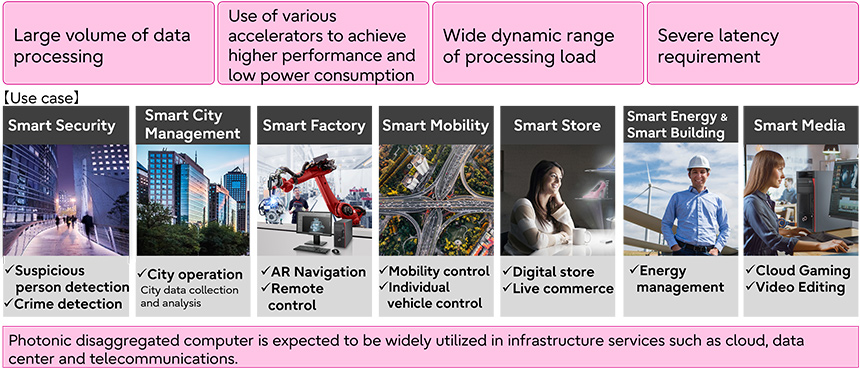
Future vision: evolution of Photonic disaggregated computer
Photonic disaggregated computer will be applied not only to single server or data center, but also to the entire ICT architecture, enabling optimal ICT resource deployment extensively.
In the future, the coverage is expected to expand to data centers which are dispersed geographically utilizing advanced photonic technology such as APN*. In other words, high performance and low power consumption ICT architecture will be built on large scale, even enabling the flexible allocation of resources across cities.
Fujitsu’s initiative for Photonic disaggregated computer
Research & Development
Fujitsu is conducting R&D for realizing Photonic disaggregated computer by utilizing our strengths in photonic and computing technologies. We also established a strategic alliance with Nippon Telegraph and Telephone Corporation to conduct joint R&D on new ICT infrastructure, including Photonic disaggregated computer.
NTT and Fujitsu Embark on Strategic Alliance to Drive "Realization of Sustainable Digital Society"Especially, we are conducting R&D on controller technology for utilization of appropriate accelerators for each processing, direct communication and processing technology between accelerators, and utilization of Photonics-Electronics convergence technology that enable photonic connection of network functions and resources.
Community activities
We believe that global and open collaboration with a wide range of partners is essential for realization and implementation of innovative technologies such as Photonic disaggregated computer. Fujitsu is participating in various global community activities such as the IOWN Global Forum* to promote the initiative of Photonic disaggregated computer.
Fujitsu's activities in IOWN Global Forum* The IOWN GLOBAL FORUM mark and IOWN GLOBAL FORUM & Design logo are trademarks of Innovative Optical and Wireless Network Global Forum, Inc. in the United States and other countries.

